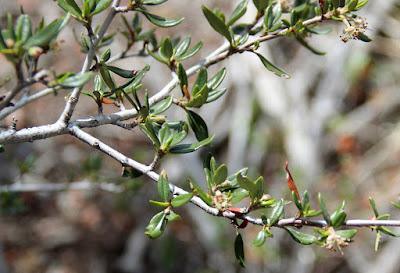 |
| Mountain mahogany in flower, field assistant for scale; Kingston Canyon, Nevada. |
For example, the yellowish flowers of curl-leaf mountain mahogany are less than a centimeter long and have no petals. But this simplicity is made up for by their abundance. At peak bloom, they turn the entire canopy yellowish brown.
 |
| Cercocarpus ledifolius var. intermontanus can be a shrub or small tree. |
 |
| Flowers by the hundreds! |
 |
| Mountain mahogany flowers. The sepals form a floral cup (hypanthium), with 10 stamens and a single pistil. |
 |
| Mountain mahogany in fruit; courtesy Andrey Zharkikh via Flickr. |
Nearby was a shrub with a very different kind of showiness, more in line with what people consider beautiful. It was covered in flowers that were large and colorful, at least by Great Basin standards. The petals were each about a centimeter long, and deep pink in bud becoming paler in flower. This is the desert peach, Prunus andersonii.
 |
| Desert peach branchlets become stiff and spiny with age. |
 |
| Prunus andersonii with sagebrush; courtesy Matt Lavin via Flickr. |
 |
| Courtesy Jason Hollinger via Flickr. |
Some will be surprised to learn that curl-leaf mountain mahogany and desert peach are in the same family. With such different flowers and fruit, how can this be?! But those of us who know the Rosaceae simply shrug in resignation. The rose family is notoriously diverse. It used to be divided into six subfamilies, most of which were treated as full-on families at one time or another. Now experts recognize three subfamilies, and within these, 16 tribes. Get the full details of this tangled web here.
Or perhaps you would prefer Robert Frost's thoughts on the Rosaceae:
The rose is a rose,
And was always a rose.
But the theory now goes
That the apple’s a rose,
And the pear is, and so’s
The plum, I suppose.
The dear only knows
What will next prove a rose.
You, of course, are a rose –
But were always a rose.
—Robert Frost, The Rose Family
Sources
Cercocarpus ledifolius in Flora North America
Prunus andersonii in Flora North America
Rosaceae in Flora North America
Mozingo, HN. 1987. Shrubs of the Great Basin. U Nevada Press.

No comments:
Post a Comment